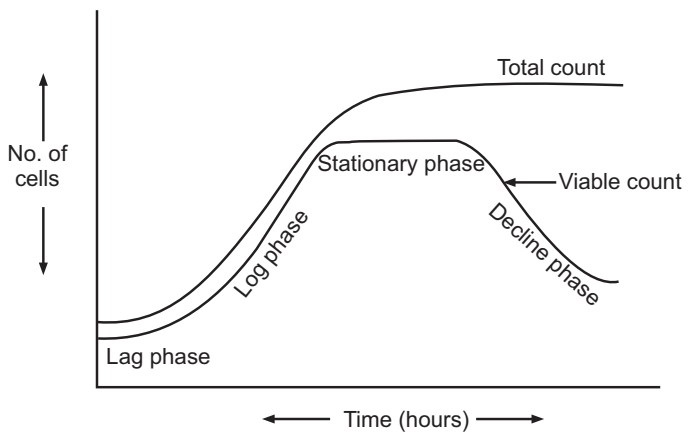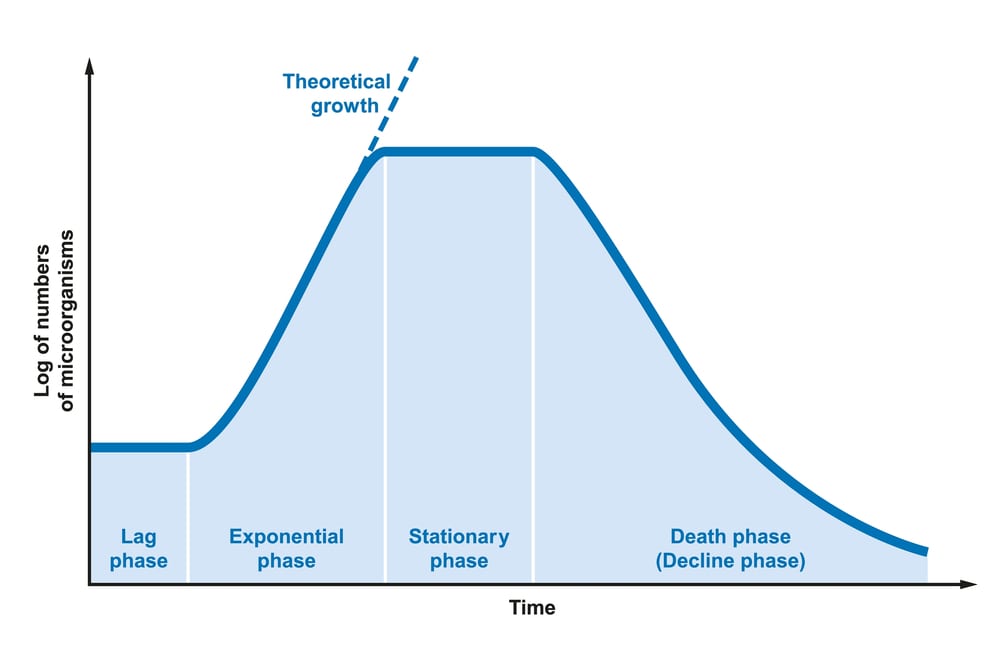The normal growth curve of bacteria can be determined by inoculating a small number of bacterial cells into a suitable culture medium and counting the bacteria in aliquot samples at regular intervals. When the logarithms of the viable cells are plotted against time on graph paper, it gives a typical curve called as bacterial growth curve or growth cycle of bacteria. The resulting curve has four distinct phases (Fig.1).
- Lag phase
- Log or logarithmic or exponential phase
- Stationary phase
- Death or decline phase.
1. Lag phase:
When bacteria are inoculated into a fresh medium, the microbial population remains constant for an initial period. The period between inoculation and the beginning of multiplication is known as the lag phase. In this phase, bacterial cells adjust themselves to adapt to the new environment. The enzymes, coenzymes, and other essential molecules are synthesized by the bacterial cell during this phase. The cells are metabolically and physiologically very active but do not divide. The length of the lag phase depends upon the nature of the medium, species of microorganisms, and other various physical and chemical growth factors.

2. Log phase (Exponential phase):
During this phase, the cells divide steadily at a constant rate, and the log of the number of cells plotted against time results in a straight line. The bacteria multiply at their maximum rate and their number increases exponentially or by geometric progression with time. The time required for one bacterial division during this phase is known as generation time. The number of bacteria present in each generation period is almost twice that in the previous period. The generation time (g) can be determined from the number of generations (n) that occur in a particular time(t).

All bacteria, do not have the same generation time. Escherichia coli may have 15 to 20 minutes, Staphylococcus aureus, 25 to 30 minutes, and Mycobacterium tuberculosis may have 780 to 940 minutes. Generation time is mainly dependent on the type of species, nutrients in the medium, and physical conditions.
The growth rate (R, number of generations/hour) is the reciprocal of the generation time (g). It is also the slope of the straight line obtained when the log number of cells is plotted against time.

3. Stationary phase:
In this phase, a constant high population of cells is maintained by a balance between cell division and cell death. The rate of multiplication is reduced because of depletion of nutrients, accumulation of toxic waste products, very high concentration of cells, and low partial pressure of oxygen. At the cellular level during the stationary phase, reserved food materials get consumed, a proportion of ribosomes may be degraded and enzymes may still be synthesized. A viable population count at this stage shows no change.
4. Death or decline phase:
The death or decline phase is also known as the logarithmic death phase. During the death phase, the number of viable cells decreases exponentially, essentially the inverse of growth during the log phase. A variety of conditions contribute to bacterial death but the most important is the depletion of nutrients and accumulation of toxic waste products. Bacteria die at different rates, just as they grow at different rates.
Between each of these phases, there is a small curved portion called the transitional period.
Synchronous growth is the growth of micro-organisms in such a way that they are all in the same stage of the growth phase and all will divide at the same time concerning each other. Thus, the entire population is kept uniform concerning growth and division. It is not possible to analyze a single bacterial cell to obtain information about growth behavior i.e. organization, differentiation, and macromolecular synthesis. Synchronous culture provides the entire cell crop in the same stage of growth. Measurements made on such cultures are equivalent to the measurements made on individual cells.
Bacterial growth characterized by two separate phases due to the preferential use of one carbon source over another is called diauxic growth. Glucose is utilized first and after the exhaustion of glucose, lactose is utilized. In between, a short lag period is seen. Diauxic growth can be obtained by preferentially utilizing certain carbon substrates. The technique by which microbial population is maintained in the exponential phase of growth in a constant environment is known as the continuous culture technique. It is necessary to maintain a bacterial population in the exponential or log phase for research and industrial processes. This condition is known as steady-state growth.
Make sure you also check our other amazing Article on : Physical Parameters For Bacterial Growth
